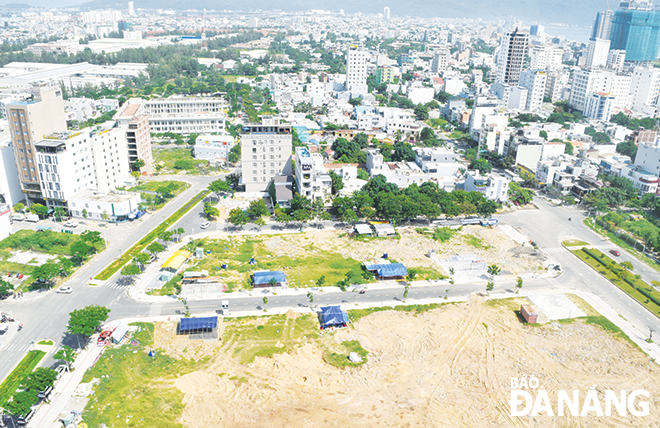Da Nang effectively taps land resources for big development strides
One of the most important conditions and resources for Da Nang to constantly develop over the past 25 years is its effective exploitation and promotion of land resources in the process of socio-economic progress.
 |
| Currently, the city is continuing to effectively exploit the land fund to create resources for socio-economic development. A large area of land along Pham Van Dong Street in Son Tra District is being exploited to create a source of economic development. Photo: HOANG HIEP |
Efficient exploitation of land resources
25 years ago, on March 29, 1997, on the 22nd anniversary of the Liberation of Da Nang, the construction of Bach Dang Dong Street (now known as Tran Hung Dao Street) was kicked off. This was the first work to ‘wake up’ the eastern bank of the Han River.
Now, Tran Hung Dao Street and the eastern bank of the Han River as a whole, have magically changed, becoming a modern urban area cum a key tourist attraction site in the city.
Prof. Dang Hung Vo, former Deputy Minister of the Ministry of Natural Resources and the Environment, once assessed that Da Nang was the only locality in Viet Nam that could create a modern city by effectively exploiting the value of the land as much as possible as developed countries did.
Da Nang has successfully generated a huge financial value from land resources to develop itself into a modern city with thriving tourism.
The main secret of Da Nang is to carry out site clearance work of the “unused” land along the eastern bank of the Han River with a low value to pave way for the building of modern streets and bridges across the river, thus creating trade connectivity and increasing the value of the land as well.
In particular, the prices of land along the eastern bank of the Han River stretching to beaches skyrocketed. The city has created added value in the land vast so as to develop the desired aspects.
More breakthrough policies needed
Dr. Huynh Huy Hoa, Director of Da Nang Institute of Socio-Economic Development, acknowledged that, in order to gain many achievements like today, the city has well implemented the policies of fully tapping the great potential of the land fund to generate income for the state budget.
The city’s collection of land use levy (from houses and land) has increased sharply since 2001 and accounted for more than 30% of the city's total budget balance in 2003, 2004 and 2007, in which, the highest was in 2004 with the proportion of more than 41%.
An outstanding success of Da Nang in effectively and rationally exploiting financial resources from land for socio-economic development is to remove the "bottlenecks" in compensation and site clearance.
Moreover, many financial policies regarding land use in Da Nang have been implemented effectively such as the rewardings for the ahead-of-schedule site handover and supportive schemes for production stabilization and resettlement. In particular, 2010, 2011 and 2012 are the three consecutive years the city chose the theme as ‘the Year of compensation, resettlement and social welfare’.
For the time being, the remaining land fund on the mainland that can be used for development projects is about 335.72km2, most of which is under development planning. Only about 18 .8% of the total land area is still vacant that can be developed in the future (mostly in the southern and southwestern sides of the city).
Therefore, in order to effectively exploit land resources in the coming time, it is high time for the city to effectively implement breakthrough policies in adjusting the Da Nang Master Plan to 2030, with a vision towards 2045 such as the development of Compact City and University Village models, hillside and seaport urban areas, mixed land use areas and new functional areas (innovation zones, high-tech agriculture areas and logistics service centres).
Director of the Da Nang Department of Natural Resources and the Environment To Van Hung said that the policy of “exchanging land for infrastructure’ is a way to create a huge investment capital, makequite a drastic change, and contribute to the expansion of the Da Nang urban scale both in quantity and quality.
The city has relocated a total of about 120,000 households to create room for the development of key projects. Till date, the city’s urban boundary has expanded from 5,600ha in the inner city to more than 21,000ha.
In the 1997 - 2020 period, the total amount of money collected from land fund exploitation reached more than VND 55,300 billion.
From now till 2025, the city is expected to collect at least VND 28,892 billion for the municipal budget from the transfer of land use rights, land allocation and auctions.
Reporting by HOANG HIEP – Translating by A. THU